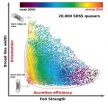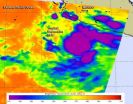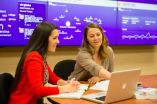(Press-News.org) When a segment of a major fault line goes quiet, it can mean one of two things: The "seismic gap" may simply be inactive — the result of two tectonic plates placidly gliding past each other — or the segment may be a source of potential earthquakes, quietly building tension over decades until an inevitable seismic release.
Researchers from MIT and Turkey have found evidence for both types of behavior on different segments of the North Anatolian Fault — one of the most energetic earthquake zones in the world. The fault, similar in scale to California's San Andreas Fault, stretches for about 745 miles across northern Turkey and into the Aegean Sea.
The researchers analyzed 20 years of GPS data along the fault, and determined that the next large earthquake to strike the region will likely occur along a seismic gap beneath the Sea of Marmara, some five miles west of Istanbul. In contrast, the western segment of the seismic gap appears to be moving without producing large earthquakes.
"Istanbul is a large city, and many of the buildings are very old and not built to the highest modern standards compared to, say, southern California," says Michael Floyd, a research scientist in MIT's Department of Earth, Atmospheric and Planetary Sciences. "From an earthquake scientist's perspective, this is a hotspot for potential seismic hazards."
Although it's impossible to pinpoint when such a quake might occur, Floyd says this one could be powerful — on the order of a magnitude 7 temblor, or stronger.
"When people talk about when the next quake will be, what they're really asking is, 'When will it be, to within a few hours, so that I can evacuate?' But earthquakes can't be predicted that way," Floyd says. "Ultimately, for people's safety, we encourage them to be prepared. To be prepared, they need to know what to prepare for — that's where our work can contribute"
Floyd and his colleagues, including Semih Ergintav of the Kandilli Observatory and Earthquake Research Institute in Istanbul and MIT research scientist Robert Reilinger, have published their seismic analysis in the journal Geophysical Research Letters.
In recent decades, major earthquakes have occurred along the North Anatolian Fault in a roughly domino-like fashion, breaking sequentially from east to west. The most recent quake occurred in 1999 in the city of Izmit, just east of Istanbul. The initial shock, which lasted less than a minute, killed thousands. As Istanbul sits at the fault's western end, many scientists have thought the city will be near the epicenter of the next major quake.
To get an idea of exactly where the fault may fracture next, the MIT and Turkish researchers used GPS data to measure the region's ground movement over the last 20 years. The group took data along the fault from about 100 GPS locations, including stations where data are collected continuously and sites where instruments are episodically set up over small markers on the ground, the positions of which can be recorded over time as the Earth slowly shifts.
"By continuously tracking, we can tell which parts of the Earth's crust are moving relative to other parts, and we can see that this fault has relative motion across it at about the rate at which your fingernail grows," Floyd says.
From their ground data, the researchers estimate that, for the most part, the North Anatolian Fault must move at about 25 millimeters — or one inch — per year, sliding quietly or slipping in a series of earthquakes.
As there's currently no way to track the Earth's movement offshore, the group also used fault models to estimate the motion off the Turkish coast. The team identified a segment of the fault under the Sea of Marmara, west of Istanbul, that is essentially stuck, with the "missing" slip accumulating at 10 to 15 millimeters per year. This section — called the Princes' Island segment, for a nearby tourist destination — last experienced an earthquake 250 years ago.
Floyd and colleagues calculate that the Princes' Island segment should have slipped about 8 to 11 feet — but it hasn't. Instead, strain has likely been building along the segment for the last 250 years. If this tension were to break the fault in one cataclysmic earthquake, the Earth could shift by as much as 11 feet within seconds.
Although such accumulated strain may be released in a series of smaller, less hazardous rumbles, Floyd says that given the historical pattern of major quakes along the North Anatolian Fault, it would be reasonable to expect a large earthquake off the coast of Istanbul within the next few decades.
"Earthquakes are not regular or predictable," Floyd says. "They're far more random over the long run, and you can go many lifetimes without experiencing one. But it only takes one to affect many lives. In a location like Istanbul that is known to be subject to large earthquakes, it comes back to the message: Always be prepared."
INFORMATION:
Seismic gap may be filled by an earthquake near Istanbul
After tracking seismic shifts, researchers say a major quake may occur off the coast of Istanbul
2014-09-10
ELSE PRESS RELEASES FROM THIS DATE:
Gibbon genome sequence deepens understanding of primates rapid chromosomal rearrangements
2014-09-10
HOUSTON – (Sep. 10. 2014) – With the completion of the sequencing and analysis of the gibbon genome, scientists now know more about why this small ape has a rapid rate of chromosomal rearrangements, providing information that broadens understanding of chromosomal biology.
Chromosomes, essentially the packaging that encases the genetic information stored in the DNA sequence, are fundamental to cellular function and the transmission of genetic information from one generation to the next. Chromosome structure and function is also intimately related to human genetic diseases, ...
Mysterious quasar sequence explained
2014-09-10
Pasadena, CA—Quasars are supermassive black holes that live at the center of distant massive galaxies. They shine as the most luminous beacons in the sky across the entire electromagnetic spectrum by rapidly accreting matter into their gravitationally inescapable centers. New work from Carnegie's Hubble Fellow Yue Shen and Luis Ho of the Kavli Institute for Astronomy and Astrophysics (KIAA) at Peking University solves a quasar mystery that astronomers have been puzzling over for 20 years. Their work, published in the September 11 issue of Nature, shows that most observed ...
Researchers discover 3 extinct squirrel-like species
2014-09-10
Paleontologists have described three new small squirrel-like species that place a poorly understood Mesozoic group of animals firmly in the mammal family tree. The study, led by scientists at the American Museum of Natural History and the Chinese Academy of Sciences, supports the idea that mammals—an extremely diverse group that includes egg-laying monotremes such as the platypus, marsupials such as the opossum, and placentals like humans and whales—originated at least 208 million years ago in the late Triassic, much earlier than some previous research suggests. The study ...
Fish and fatty acid consumption associated with lower risk of hearing loss in women
2014-09-10
BOSTON, MA – Researchers at Brigham and Women's Hospital found that consumption of two or more servings of fish per week was associated with a lower risk of hearing loss in women. Findings of the new study Fish and Fatty Acid Consumption and Hearing Loss study led by Sharon G. Curhan, MD, BWH Channing Division of Network Medicine, are published online on September 10 in the American Journal of Clinical Nutrition (AJCN).
"Acquired hearing loss is a highly prevalent and often disabling chronic health condition," stated Curhan, corresponding author. "Although a decline ...
Research identifies drivers of rich bird biodiversity in Neotropics
2014-09-10
An international team of researchers is challenging a commonly held view that explains how so many species of birds came to inhabit the Neotropics, an area rich in rain forest that extends from Mexico to the southernmost tip of South America. The new research, published today in the journal Nature, suggests that tropical bird speciation is not directly linked to geological and climate changes, as traditionally thought, but is driven by movements of birds across physical barriers such as mountains and rivers that occur long after those landscapes' geological origins.
"The ...
UT Arlington research uses nanotechnology to help cool electrons with no external sources
2014-09-10
A team of researchers has discovered a way to cool electrons to −228 °C without external means and at room temperature, an advancement that could enable electronic devices to function with very little energy.
The process involves passing electrons through a quantum well to cool them and keep them from heating.
The team details its research in "Energy-filtered cold electron transport at room temperature," which is published in Nature Communications on Wednesday, Sept. 10.
"We are the first to effectively cool electrons at room temperature. Researchers have done ...
NASA catches birth of Tropical Storm Odile
2014-09-10
The Eastern Pacific Ocean continues to turn out tropical cyclones and NASA's Aqua satellite caught the birth of the fifteenth tropical depression on September 10 and shortly afterward, it strengthened into a tropical storm and was renamed Odile.
The Atmospheric Infrared Sounder or AIRS instrument that flies aboard NASA's Aqua satellite captured infrared data on Tropical Depression 15-E on September 10 at 8:53 UTC (4:53 a.m. EDT) when it developed. The National Hurricane Center named the depression at 5 a.m. EDT, when the center was located near latitude 14.4 north and ...
A new way to look at diabetes and heart risk
2014-09-10
People with diabetes who appear otherwise healthy may have a six-fold higher risk of developing heart failure regardless of their cholesterol levels, new Johns Hopkins Bloomberg School of Public Health research suggests.
In nearly 50 percent of people with diabetes in their study, researchers employing an ultra-sensitive test were able to identify minute levels of a protein released into the blood when heart cells die. The finding suggests that people with diabetes may be suffering undetectable – but potentially dangerous – heart muscle damage possibly caused by their ...
Study: Sports broadcasting gender roles echoed on Twitter
2014-09-10
Twitter provides an avenue for female sports broadcasters to break down gender barriers, yet it currently serves to express their subordinate sports media roles.
This is the key finding of a new study by Clemson University researchers and published in the most recent issue of Journal of Sports Media.
"Social media has been embraced by the sports world at an extraordinary pace and has become a viable avenue for sports broadcasters to redefine their roles as celebrities," said Melinda Weathers, lead author on the study and assistant professor of communication studies ...
Cyberbullying increases as students age
2014-09-10
RIVERSIDE, Calif. — As students' age they are verbally and physically bullied less but cyberbullied more, non-native English speakers are not bullied more often than native English speakers and bullying increases as students' transition from elementary to middle school.
Those are among the findings of a wide-ranging paper, "Examination of the Change in Latent Statuses in Bullying Behaviors Across Time," recently published in the journal School Psychology Quarterly.
Authors of the paper are: Cixin Wang, an assistant professor at the University of California, Riverside's ...
LAST 30 PRESS RELEASES:
Numbers in our sights affect how we perceive space
SIMJ announces global collaborative book project in commemoration of its 75th anniversary
Air pollution exposure and birth weight
Obstructive sleep apnea risk and mental health conditions among older adults
How talking slows eye movements behind the wheel
The Ceramic Society of Japan’s Oxoate Ceramics Research Association launches new international book project
Heart-brain connection: international study reveals the role of the vagus nerve in keeping the heart young
Researchers identify Rb1 as a predictive biomarker for a new therapeutic strategy in some breast cancers
Survey reveals ethical gaps slowing AI adoption in pediatric surgery
Stimulant ADHD medications work differently than thought
AI overestimates how smart people are, according to HSE economists
HSE researchers create genome-wide map of quadruplexes
Scientists boost cell "powerhouses" to burn more calories
Automatic label checking: The missing step in making reliable medical AI
Low daily alcohol intake linked to 50% heightened mouth cancer risk in India
American Meteorological Society announces Rick Spinrad as 2026 President-Elect
Biomass-based carbon capture spotlighted in newly released global climate webinar recording
Illuminating invisible nano pollutants: advanced bioimaging tracks the full journey of emerging nanoscale contaminants in living systems
How does age affect recovery from spinal cord injury?
Novel AI tool offers prognosis for patients with head and neck cancer
Fathers’ microplastic exposure tied to their children’s metabolic problems
Research validates laboratory model for studying high-grade serous ovarian cancer
SIR 2026 delivers transformative breakthroughs in minimally invasive medicine to improve patient care
Stem Cell Reports most downloaded papers of 2025 highlight the breadth and impact of stem cell research
Oxford-led study estimates NHS spends around 3% of its primary and secondary care budget on the health impacts of heat and cold in England
A researcher’s long quest leads to a smart composite breakthrough
Urban wild bees act as “microbial sensors” of city health.
New study finds where you live affects recovery after a hip fracture
Forecasting the impact of fully automated vehicle adoption on US road traffic injuries
Alcohol-related hospitalizations from 2016 to 2022
[Press-News.org] Seismic gap may be filled by an earthquake near IstanbulAfter tracking seismic shifts, researchers say a major quake may occur off the coast of Istanbul





